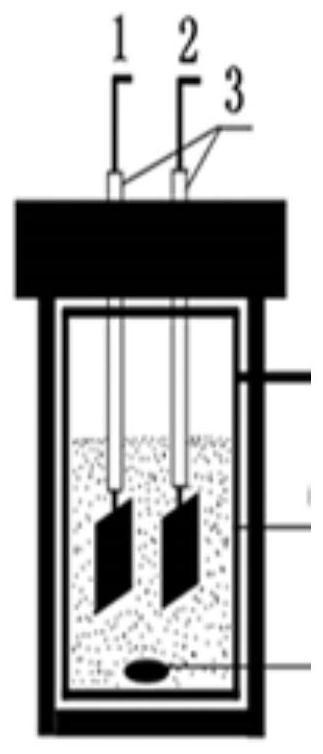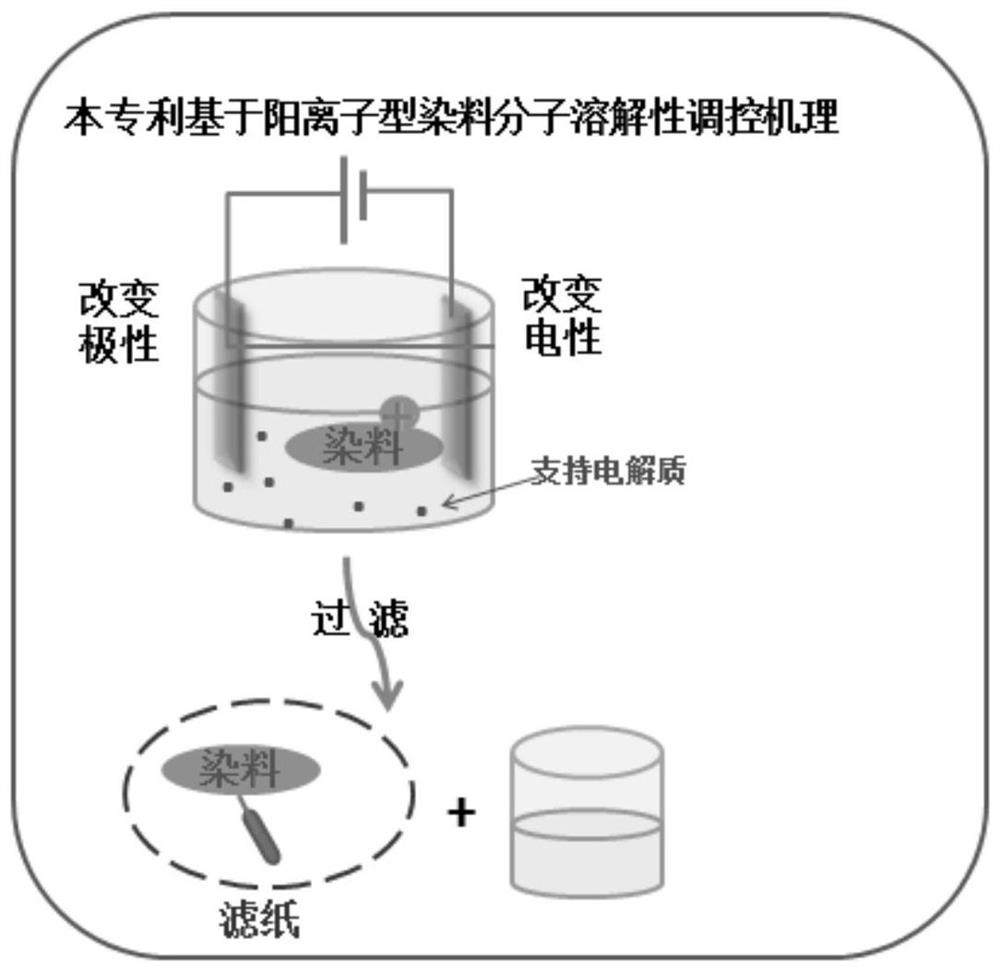A method of processing cationic dye wastewater based on electrochemical modification method
A cationic dye, electrochemical technology, applied in the field of organic wastewater treatment, achieves the effects of simple equipment, short treatment time and low energy consumption
- Summary
- Abstract
- Description
- Claims
- Application Information
AI Technical Summary
Problems solved by technology
Method used
Image
Examples
Embodiment 1
[0037] A method for treating cationic dye wastewater based on an electrochemical modification method, the specific steps are as follows:
[0038] 1) Add 50mg of methylene blue to 1000mL of distilled water, the concentration of methylene blue is 0.0500g / L, as the simulated cationic dye wastewater;
[0039] 2) Add 1.0000g tetrabutylammonium chloride and 3.5000g sodium bicarbonate to the wastewater system described in step 1), stir and dissolve, and the concentration of tetrabutylammonium chloride in the simulated cationic dye wastewater system is 0.0036mol / L , the concentration of sodium bicarbonate is 0.0417mol / L, adding sulfuric acid to adjust the pH of the solution is 7.5, get 1.5ml of this solution and filter and measure its absorbance at the methylene blue maximum absorption wavelength place (664nm), which is 8.490A;
[0040] 3) In a 2000mL single-chamber electrolytic cell, add 1000mL of the solution prepared in step 2), 2 Platinum electrode as the anode of the electrolyti...
Embodiment 2
[0044] A method for treating cationic dye wastewater based on an electrochemical modification method, the specific steps are as follows:
[0045] 1) Add 100mg of methylene blue to 1000mL of distilled water, the concentration of methylene blue is 0.1000g / L, as the simulated cationic dye wastewater;
[0046] 2) Add 1.1600g tetrabutylammonium bromide and 3.5000g sodium citrate to the wastewater system described in step 1), stir and dissolve, and the concentration of tetrabutylammonium bromide in the simulated cationic dye wastewater system is 0.0035mol / L , the concentration of sodium citrate is 0.0135mol / L, adding sulfuric acid to adjust the pH of the solution is 6.5, get 1.5ml of this solution and filter and measure its absorbance at the methylene blue maximum absorption wavelength place (664nm), which is 15.18A;
[0047] 3) In a 2000mL single-chamber electrolytic cell, add 1000mL of the solution prepared in step 2), with an area of 40cm 2 The graphite sheet electrode is used...
Embodiment 3
[0051] A method for treating cationic dye wastewater based on an electrochemical modification method, the specific steps are as follows:
[0052] 1) Add 200mg of methylene blue to 1000mL of distilled water, the concentration of methylene blue is 0.2000g / L, as the simulated cationic dye wastewater;
[0053] 2) Add 2.0000g tetrabutylammonium iodide and 2.0000g ammonium dihydrogen phosphate to the wastewater system described in step 1), stir and dissolve, and the concentration of tetrabutylammonium iodide in the simulated cationic dye wastewater system is 0.0054mol / L, the concentration of ammonium dihydrogen phosphate is 0.0174mol / L, adding sodium hydroxide to adjust the pH of the solution is 8.5, get 1.5ml of this solution and filter and measure its absorbance at the methylene blue maximum absorption wavelength place (664nm), which is 29.00A;
[0054] 3) In a 2000mL single-chamber electrolytic cell, add 1000mL of the solution prepared in step 2), and 2 Graphite sheet electrode...
PUM
| Property | Measurement | Unit |
|---|---|---|
| concentration | aaaaa | aaaaa |
| absorbance | aaaaa | aaaaa |
| absorbance | aaaaa | aaaaa |
Abstract
Description
Claims
Application Information
 Login to View More
Login to View More - R&D
- Intellectual Property
- Life Sciences
- Materials
- Tech Scout
- Unparalleled Data Quality
- Higher Quality Content
- 60% Fewer Hallucinations
Browse by: Latest US Patents, China's latest patents, Technical Efficacy Thesaurus, Application Domain, Technology Topic, Popular Technical Reports.
© 2025 PatSnap. All rights reserved.Legal|Privacy policy|Modern Slavery Act Transparency Statement|Sitemap|About US| Contact US: help@patsnap.com


